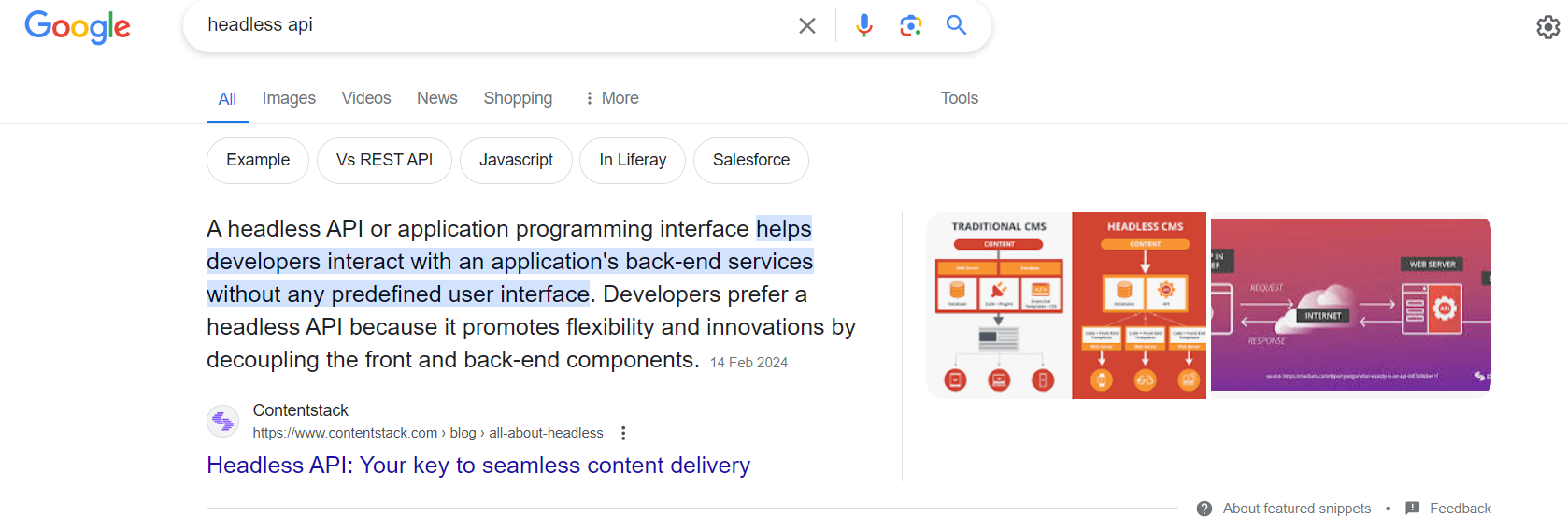The power of SEO-rich text: Improve your website's CTR

Discover what SEO-rich text is and how it enhances your content's visibility on SERPs. The rich text works by increasing the click-through rate, user engagement and businesses' online visibility. If you want to know more about SEO-rich content, talk to us today.
Highlights
You’ll learn about:
What is SEO-rich text
- Structured data markup added to HTML
- Helps search engines display content attractively and informatively
Benefits of SEO-rich text
- Enhances click-through rates (CTR): More informative and enhanced search results drive higher clicks
- Increases online visibility: Increases organic traffic and impressions
- Higher user engagement: Engages your visitors for a longer time
Improve your website's performance by making SEO-rich text an integral part of your content strategy.
Keep reading to learn more!
Think about the last time you searched on Google. The information appeared at the top of the search engine results pages (SERPs) as a “Featured snippet.” So, is there any secret ingredient that makes your content rank as a “Featured snippet," or is it just your luck? Google calls it search engine optimization or SEO-rich text, which can do wonders for your website’s SEO.
SEO-rich text boosts search results because it helps you stand out from competitors and offers searchers additional information. And, with a short human attention span, these small aspects make your website more engaging and informative.
To make the SEO-rich texts work, read on to explore what they mean, why they matter and how you can use them to give your website an advantage.
What is SEO-rich text?
SEO-rich text is a type of structured data markup that webmasters add to their existing HTML. When you use rich text, it becomes easier for search engines to understand the information on each page, giving customers an idea of whether the page has the information they want without clicking on it.
Let’s say you’re searching for a “garlic bread recipe” on Google.
In the search results, you see the website’s title and description and other useful details like the recipe’s rating, cooking time, reviews and ingredients, allowing you to choose one—that’s your SEO-rich text or rich snippet.
You can implement the structured data markup using schema.org vocabulary and integrate it into web pages using JSON-LD, Schema Microdata, or RDFa.
This is what a rich snippet looks like:

Types of SEO-rich text
Reviews and ratings snippets
These are review snippets giving information about the star rating and the number of reviews for a hotel, restaurant, business, or movie.
Products
Showcases information like the price, availability and rating—ideal for e-commerce websites.
Recipes
The recipe snippet contains cooking time, photo thumbnail, calorie count, cooking time, prep time, ingredient list and overall recipe rating.
Events
Displays details like time, date, location and event ticket price.
FAQs
Directly answers user queries, displaying the questions and the answers on the search engine result pages, making it easier to find helpful content. An example of how FAQs are displayed:
Modernize your digital presence with Contentstack. Learn from the success stories of Icelandair and Pella. Improve your site performance, publishing efficiency, and speed, just as they did. Start your journey towards a modern digital experience. Start your free trial with Contentstack today and witness an ROI of up to 295%.
Videos
The video snippet displays the thumbnail image along with the duration and description of the video content in the search results. This is helpful for users who consume video content.
Benefits of using SEO-rich text for business
With rich snippets generating an average of 58 clicks per 100 queries, focusing on SEO to implement rich text snippets makes your content more attractive and enticing for customers to click on it. But the benefits of a rich snippet don’t stop here. Rich snippets:
Improves conversion rates
SEO-rich text attracts customers who are actively searching for services, products, and information you offer, increasing your conversion rate. The rich text works by pre-qualifying your traffic and drawing in people who are more likely to become loyal customers. Someone who clicks on your rich snippet will see the price and review of your products or services rather than just a generic link.
Enhances click-through rate
When your search results are more informative and attractive, more customers will click on your links, enhancing your click-through rate. Think about it—if you’re searching for a garlic bread recipe and one result displays a mouthwatering image, ratings and reviews, you’ll probably choose it over another result showing just a link. Providing extra and helpful details goes a long way in encouraging customers to make a purchase.
Higher online visibility
While rich text doesn’t directly increase or decrease your search engine rankings, it significantly impacts your organic traffic and online visibility. As more customers see your information, your impressions and clicks increase, increasing organic traffic. SEO-rich snippets make it easier for spiders to index your website more accurately, ensuring your content displays in many search results.
How has Contentstack improved the editing and publishing speed of LADbible Group?
The LADbible Group moved from an in-house content system to Contentstack to make their systems flexible and scalable. The team praised Contentstack's extensibility, developer tools and efficient editing capabilities, which improved their workflow. Key benefits include faster and cost-effective content creation, the ability to share and customize content across 55 brand sites and a twofold increase in editorial process speed. LADbible liked that they could integrate with third-party apps to make their editing and publishing more efficient. This type of integration allows the company to integrate, for instance, with SEO tools. They can use Contentstack’s AI Assistant to generate SEO-rich text.
After using Contentstack, Tom McGiveron, Lead Software Engineer, said:
“Contentstack gives us a solid base that’s easily extensible. We’re now able to turn out new features quickly and implement them in an elegant way.”
Read the complete case study here.
Increased user engagement
SEO-rich snippets can improve user engagement once potential customers arrive on your website. The structured data markup gives your customers glimpses of what to expect. When customers see reviews and a detailed step-by-step guide of the recipe they’re searching for, they’ll stay on your page longer.
How to implement SEO-rich text
Conduct thorough keyword research
Identify the most relevant keywords and phrases your customers search for. Tools like Google Keyword Planner, Ahrefs and SEMrush can help you.
Create high-quality content
Publish high-quality images that meet the search intent of your audience. To make your content appear as rich snippets, avoid keyword stuffing. Rather, naturally, incorporate relevant keywords back into your content.
Optimize headers and subheaders
Use a mix of H1, H2 and H3 tags. Inserting your main keyword at least once in your headers helps search engines understand the structure and focus of your content. The pages must have valid and well-formatted structured data using Schema. Common types include products, recipes, reviews, videos and FAQs.
Include internal and external links
Link to other pages within your website to improve navigation and retention time. Adding links to reputable external sources brings credibility and more traffic and builds trust and value.
Optimize images and media
Use alt tags to describe images and optimize all media files for faster loading speed. This helps search engines understand the content of your images and improves search rankings and accessibility.
Write a compelling meta description and title
Your meta tags, descriptions and titles should be attractive. Remember to include your primary keyword. These elements are often the customer's first impression of your page in the SERPs.
Use rich text fields for metadata
If you're using a headless content management system (CMS) like Contentstack, ensure that your rich text fields are populating with SEO metadata descriptions to enhance the visibility and effectiveness of your SEO efforts.
Best practices for SEO-rich text
Select a rich-snippet type
Identify the type of rich snippet you want to achieve. That way, it becomes easier to use a structured markup to rank as a “Featured snippet.” There are numerous snippets to choose from, such as reviews, flight information and music length, but these are limited to certain industries. It’s important to note structured markup and data's role—it helps search engines understand your content. If you play your cards right, Google is more likely to rank your blog, article, video, or image as a rich snippet.
Use structured data with schema
Most websites rely on Schema markup for structured data. All you have to do to implement structured data markup is choose the appropriate Schema type, generate it and add it to the HTML of your webpage. After implementing structured data, monitor your search performance using Google Search Console. Look for changes in how your web page appears in search results pages.
Provide valuable information
SEO-rich text is about giving your users valuable and additional context and information on the search or search engine results page. But you cannot provide any information—only accurate and useful information ranks as a “Featured snippet.”
When using structured data in a headless CMS, make sure you offer valuable details like:
- For a recipe, it’s the prep time and number of servings.
- For an event, it’s the date, location and ticket prices.
Leader in content experience platforms. The Aragon Research Globe™ award recognizes how Contentstack’s low-code, easy content creation and publishing and advanced front-end hosting redefine customer experiences. Join our group demo to experience this dynamic solution.
Understanding structured data markup for SEO
Structured data markup is labeling your content using data structures. These data structures help search engines interpret and represent information. Implementing structured data on your website leads to more accurate indexing and the display of rich results.
Structured data assigns specific attributes to various elements on your web pages, turning unstructured content into machine-readable data that search engines understand.
To get started with structured data markup, follow these steps:
- Identify relevant content: Determine which types of content on your site would benefit from structured data.
- Choose the right vocabulary: Use Schema.org to find the appropriate markup for your content. It provides a comprehensive list of schemas that describe various informational entities.
- Implement the markup: Insert the structured data into your HTML code. You can encode the data using JSON-LD, Microdata or RDFa.
- Test and validate: Use tools such as Google’s Rich Results Test and Structured Data Testing Tool to implement your structured data and ensure it’s error-free.
FAQs
What is a rich result in SEO?
A rich result is a type of search result that goes beyond generic links. It entails images, carousels, reviews and other components to deliver extra information to customers.
Do rich snippets help SEO?
Yes, rich snippets help your SEO. They give detailed information during a search and more effectively convince customers to follow a link and visit your site.
What is the use of rich snippets?
Rich snippets present additional context about a web page's content directly within search results. This includes star ratings for reviews, event details, product specifications and recipe ingredients. Rich snippets assist search engines to make listings more attractive and informative.
What are snippets in SEO?
In SEO, snippets are a portion of information located below the title of a particular page in search engine results lists. Some of these features are a web page's title, URLs and meta descriptions. Rich snippets provide users with extra information, ratings and images.
Learn more
So, by now, you understand why rich snippets matter for your SEO ranking. Ultimately, it’s all about making your content stand out. Using structured data and data markup sets you up for success.
SEO-rich text makes your content visually appealing and even drives more qualified traffic to your website.
If you want to understand how a headless CMS like Contentstack helps you with SEO-rich text, talk to us today.
About Contentstack
The Contentstack team comprises highly skilled professionals specializing in product marketing, customer acquisition and retention, and digital marketing strategy. With extensive experience holding senior positions at renowned technology companies across Fortune 500, mid-size, and start-up sectors, our team offers impactful solutions based on diverse backgrounds and extensive industry knowledge.
Contentstack is on a mission to deliver the world’s best digital experiences through a fusion of cutting-edge content management, customer data, personalization, and AI technology. Iconic brands, such as AirFrance KLM, ASICS, Burberry, Mattel, Mitsubishi, and Walmart, depend on the platform to rise above the noise in today's crowded digital markets and gain their competitive edge.
In January 2025, Contentstack proudly secured its first-ever position as a Visionary in the 2025 Gartner® Magic Quadrant™ for Digital Experience Platforms (DXP). Further solidifying its prominent standing, Contentstack was recognized as a Leader in the Forrester Research, Inc. March 2025 report, “The Forrester Wave™: Content Management Systems (CMS), Q1 2025.” Contentstack was the only pure headless provider named as a Leader in the report, which evaluated 13 top CMS providers on 19 criteria for current offering and strategy.
Follow Contentstack on LinkedIn.






.svg?format=pjpg&auto=webp)
.svg?format=pjpg&auto=webp)
.png?format=pjpg&auto=webp)






.png?format=pjpg&auto=webp)


